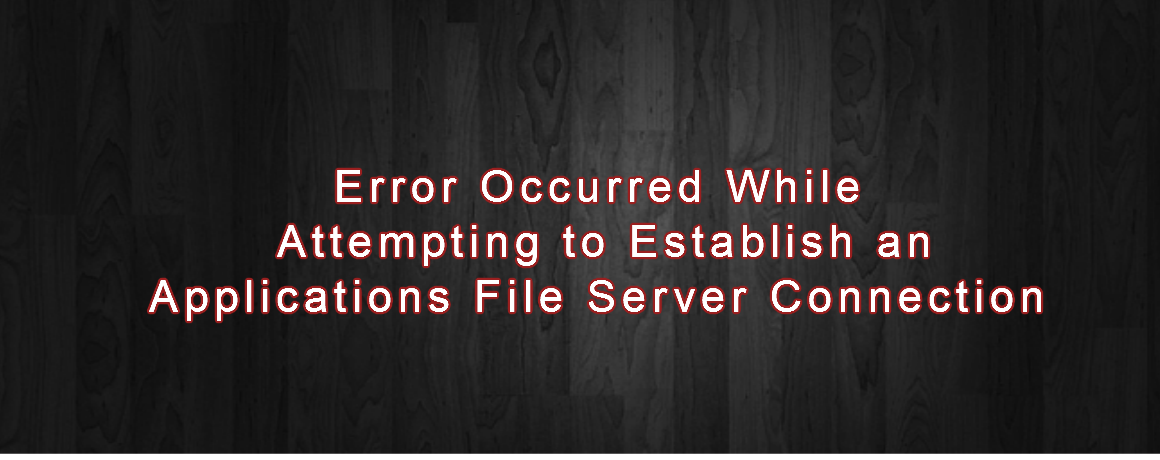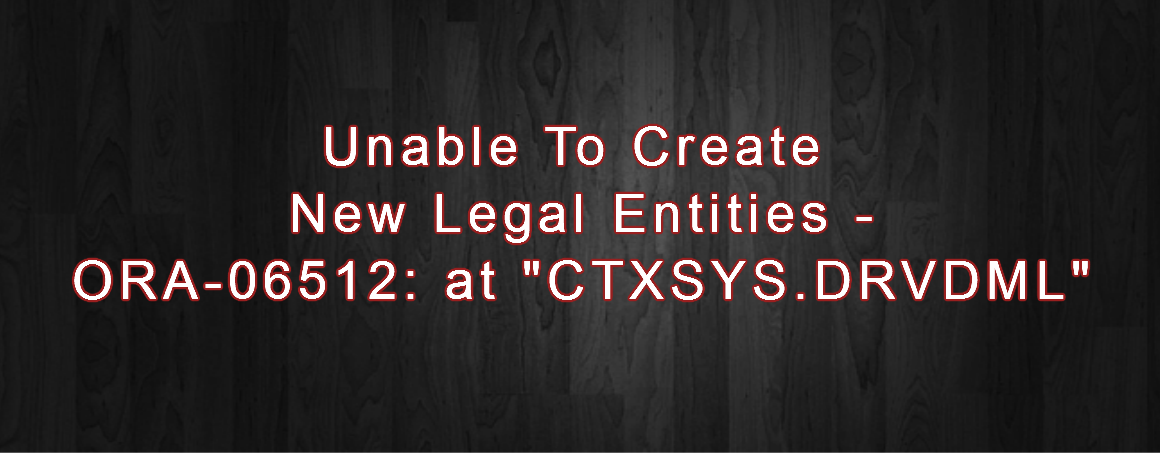Oracle ACE Pro
Oracle Solution Architect
Oracle E-Business Suite
Oracle Cloud Infrastructure
Oracle Fusion Middleware
Oracle Database Administration
Oracle Weblogic Administration
Oracle ACE Pro
Oracle Solution Architect
Oracle E-Business Suite
Oracle Cloud Infrastructure
Oracle Fusion Middleware
Oracle Database Administration
Oracle Weblogic Administration
Month: April 2017
ERROR
” An error occurred while attempting to establish an Applications File Server connection. There may be a network configuration problem, or the TNS listener may not be running on ” Solutions to Check
SOLUTION
1. Is this a Multinode Install or a Single Node Install.
– If this is a Multinode Install, you will need access to the Middle Tier and the Backend Tier (Concurrent Processor) 8.0.6 ORACLE_HOME/network/admin/tnsnames.ora files
– If this is a Single Node Install, you need access to the Concurrent Processor 8.0.6 ORACLE_HOME/network/admin/tnsnames.ora file
2. Run a report, is there actually a Report Output and Log file being produced at the Operating System level?
– Check the $APPLCSF/out and the $APPLCSF/log directories for the Request_ID out and log file
– If there are no log and output file being produces there Check the permissions on those directories (APPLMGR should have write)
– If $APPLCSF is not set, check the $FND_TOP/log and out for output and logs
3. Confirm that there are 2 listener processes actively running for the Instance that you cannot view reports on — 1 from 8.0.6 and from 8.1.6 directory structures
– type the following:
ps -ef | grep tnslsnr
– If there is only 1 listener running from the 8.1.6 directory structure
That is the Database Listener
The FNDFS listener needs to be started separately from the Database Listener
– To start the FNDFS Listener:
a. Log the Operating System Level as the APPLMGR account user
b. Set the environment for the $APPL_TOP & 8.0.6 $ORACLE_HOME (APPSORA.env)
c. Go to the $OAD_TOP/admin/scripts (Common_top area)
d. Run the following script:
adalnctl.sh start APPS_SID
(you can confirm the FNDFS Listener name from viewing the 8.0.6 ORACLE_HOME/network/admin/listener.ora file)
4. Check the actual machine name for the Concurrent Processor Server
– type the following:
uname -n
5. Go to the Applications and check the CONCURRENT > MANAGER > ADMINISTER screen in the System Administrator Responsibility The INTERNAL MANAGER NODE NAME,is it the same as what was returned from question 4?
– If it is the same then continue with next step
– If it is not the same,
Shutdown Concurrent Managers and update the FND table:
a. Go to the $OAD_TOP/admin/scripts
b. adcmctl.sh apps/apps stop
c. Connect to SQL*PLUS apps/apps
d. SQL > select target_node from FND_CONCURRENT_QUEUES;
——————–
This may return the name of an old machine
e. SQL > update FND_CONCURRENT_QUEUES set target_node=” where target_node=”;
f. SQL > commit;
g. SQL > exit
h. adcmctl.sh apps/apps start
6. In the 8.0.6 TNSNAMES.ora file, look at the FNDFS_ connection string entry.
Is the hostname value the same as is in questions 4?
– The Rapid Install creates 2 or sometimes 3 FNDFS entries in the TNSNAMES.ora
a. 1 with the FNDFS_
b. 1 with the FNDFS_
c. 1 with the FNDFS_
– The one that is the correct entry is FNDFS_ (hostname being what is returned from a “uname -n”)
– If this file does not contain the correct Hostname value
Make a backup of it and edit it to change the FNDFS entry.
7. Check the Network Connection for the FNDFS entry that was defined by the Rapid Install.
– At the Operating System Level
a. tnsping FNDFS_
– This should return the Hostname and Port information identical to the FNDFS entry in the TNSNAMES.ora file
8. Check the Following PROFILE > SYSTEM Options in The System Administrator Responsibility
CONCURRENT: Report Access Level (this must be set to USER or RESPONSIBILITY)
RRA: Service Prefix (this should be BLANK)
RRA: Enabled (this must be set to YES)
VIEWER: Text (this should be BLANK to view with the default text viewer)
Viewer: Text can Be set to “browser” to view with Netscape or IE
9. This step should be performed in a case where there might have been patches applied and possibly the FNDFS executable was not Relinked, or it may be missing from the file system or corrupted.
– Shutdown the FNDFS Listener
$OAD_TOP/admin/scripts/adalnctl.sh stop APPS_SID
– Rename or Move the Current FNDFS executable before relinking
a. $FND_TOP/bin
mv FNDFS FNDFS.bak
b. As APPLMGR account user
adrelink.sh force=y “fnd FNDFS”
– Start the FNDFS Listener
$OAD_TOP/admin/scripts/adalnctl.sh start APPS_SID
[edsanimate_start entry_animation_type= “fadeIn” entry_delay= “1” entry_duration= “0.5” entry_timing= “linear” exit_animation_type= “” exit_delay= “” exit_duration= “” exit_timing= “” animation_repeat= “infinite” keep= “yes” animate_on= “load” scroll_offset= “” custom_css_class= “”]
Metalink Note : ID 117012.1
[edsanimate_end]
Forms Servlet mode to Socket mode conversion on Release 12 Apps
Run the following command to enable Forms Socket Mode on Forms/web nodes (Place correct context file name and port value)
$FND_TOP/bin/txkrun.pl -script=ChangeFormsMode -contextfile=$CONTEXT_FILE -mode=socket -port=9030 -runautoconfig=No
Where port = forms port and contextfile=your environment contextfile
To Start/Stop/check Status of forms servers use following scripts
$cd $ADMIN_SCRIPTS_HOME
$./adformsrvctl.sh status/stop/start
ERROR
Unable To Create New Legal Entities – ORA-06512: at “CTXSYS.DRVDML” , ORA-06512: at “HR.DR$HR_LOCATIONS_N1TC
1.What is dynamic remastering? When will the dynamic remastering happens?
- Dynamic Remastering is ability to move the ownership of resource from one instance to another instance in RAC.
- Dynamic Resource remastering is used to implement for resource affinity for increased performance.
- Resource affinity optimized the system in situation where update transactions are being executed in one instance.
- When activity shift to another instance the resource affinity correspondingly move to another instance.
- If activity is not localized then resource ownership is hashed to the instance.
2.How you check the health of Your RAC Database?
‘crsctl’ command from Root or Oracle user can be used to check the clusterware health ,while for starting or stopping we have to use Root user or any privilege user.
$ crsctl check crs
3.If there is some issue with virtual IP how will you troubleshoot it?How will you change virtual ip?
To change the VIP (virtual IP) on a RAC node, use the command:
$ srvctl modify nodeapps -A new_address
4. Give Details on ACMS?
ACMS stands for Atomic Controlfile Memory Service.
In an Oracle RAC environment ACMS is an agent that ensures a distributed SGA memory update, (i.e.) SGA updates are globally committed on success or globally aborted in event of a failure.
5.What are the major RAC wait events?
- In a RAC environment the buffer cache is global across all instances in the cluster and hence the processing differs. The most common wait events related to this are gc cr request and gc buffer busy
- GC CR request is the time it takes to retrieve the data from the remote cache
- Reason: RAC Traffic Using Slow Connection or Inefficient queries (poorly tuned queries will increase the amount of data blocks requested by an Oracle session.
- GC BUFFER BUSY is the time remote instance locally spends accessing the requested data block.
6. Give details on GTX0-j?
- This process provides transparent support for XA global transactions in a RAC environment.
- The database auto-tunes the number of these processes based on the workload of XA global transactions.
7.Give details on LMON?
- This process monitors global enques and resources across the cluster and performs global enqueue recovery operations.
- This is called as Global Enqueue Service Monitor.
8. Give details on LMD?
- This process is called as global enqueue service daemon.
- This process manages incoming remote resource requests within each instance.
9. Give details on LMS?
- This process is called as Global Cache service process.
- This process maintains statuses of datafiles and each cahed block by recording information in a Global Resource Dectory(GRD).
- This process also controls the flow of messages to remote instances and manages global data block access and transmits block images between the buffer caches of different instances.
- This processing is a part of cache fusion feature.
10. Give details on LCK0?
- This process is called as Instance enqueue process.
- This process manages non-cache fusion resource requests such as library and row cache requests.
11. Give details on RMSn?
- This process is called as Oracle RAC management process.
- These processes perform manageability tasks for Oracle RAC.
- Tasks include creation of resources related Oracle RAC when new instances are added to the cluster.
12. Give details on RSMN?
- This process is called as Remote Slave Monitor.
- This process manages background slave process creation and communication on remote instances.
- This is a background slave process.
- This process performs tasks on behalf of a co-ordinating process running in another instance.
13. Can we use crossover cables with Oracle Clusterware interconnects?
No, crossover cables are not supported with Oracle Clusterware interconnects.
14.How do users connect to database in an Oracle RAC environment?
- Users can access a RAC database using a client/server configuration or through one or more middle tiers, with or without connection pooling.
- Users can use oracle services feature to connect to database.
15. Why should we have separate homes for ASM instance?
- It is a good practice to have ASM home separate from the database home(ORACLE_HOME).
- This helps in upgrading and patching ASM and the Oracle database software independent of each other.
- Also,we can deinstall the Oracle database software independent of the ASM instance.
16. What is the advantage of using ASM?
- Having ASM is the Oracle recommended storage option for RAC databases as the ASM maximizes performance by managing the storage configuration across the disks.
- ASM does this by distributing the database file across all of the available storage within our cluster database environment.
17.What is rolling upgrade?
- It is a new ASM feature from Database 11g.
- ASM instances in Oracle database 11g release(from 11.1) can be upgraded or patched using rolling upgrade feature.
- This enables us to patch or upgrade ASM nodes in a clustered environment without affecting database availability.
- During a rolling upgrade we can maintain a functional cluster while one or more of the nodes in the cluster are running in different software versions.
18. Can rolling upgrade be used to upgrade from 10g to 11g database?
No,it can be used only for Oracle database 11g releases(from 11.1).
19. How do we remove ASM from a Oracle RAC environment?
We need to stop and delete the instance in the node first in interactive or silent mode. After that ASM can be removed using srvctl tool as follows:
srvctl stop asm -n node_name
srvctl remove asm -n node_name
We can verify if ASM has been removed by issuing the following command:
srvctl config asm -n node_name





